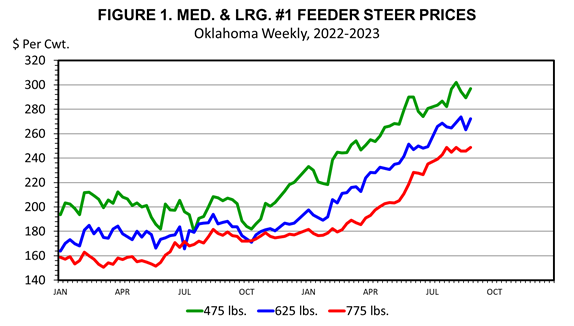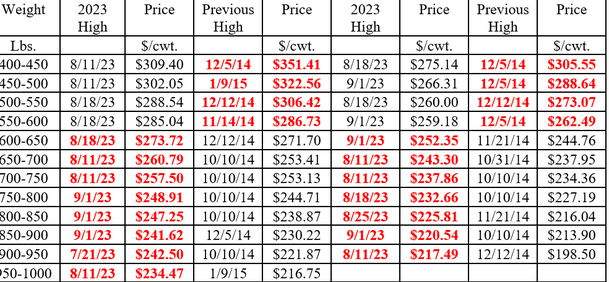
Feeder cattle prices have increased sharply in 2023. Figure 1 shows the increase in Oklahoma combined auction feeder prices that started in late 2022. In the last four weeks, prices for lightweight calves and stockers under 600 pounds have averaged about 45 percent higher year over year, with heavier feeder cattle prices up slightly less, from 37 to 40 percent over last year.
Cattle prices are trending higher in response to ever tightening cattle and beef supply fundamentals. The beef cow herd on January 1, 2023 was the lowest since 1962 and is still getting smaller. The projected 2023 U.S. calf crop is 2.5 million head smaller than the recent peak in 2018 and leads to an estimated July 1 feeder cattle supply down 3.6 percent year over year and the smallest since 2017. Feedlot inventories have been smaller year over year since September 2022. Cattle slaughter is down 3.9 percent so far this year, leading to a 4.9 percent year over year decrease in beef production for the year to date.

Feeder cattle prices have reached record levels or are rapidly approaching record levels. Table 1 shows record weekly Oklahoma steer and heifer prices by weight group. As seen in the table, all feeder steer and heifer prices for animals over 600 pounds are already at new record levels. Prices for lightweight feeders are expected to reach new record levels in the coming weeks and months. Table 1 will soon be out of date as feeder cattle prices are expected to continue moving higher.
Table 1. Oklahoma Combined Auction Prices for Steers and Heifers, Record Weekly Prices and Dates as of September 1, 2023*

Cattle prices have advanced quickly; in some ways faster than expected. The highest cattle prices will occur when herd rebuilding begins in earnest. The retention of heifers and reduced cow culling will squeeze feeder cattle supplies, cattle slaughter, and beef production to sharply lower levels. This process has not yet started and is expected to proceed rather slowly when it does begin. Herd rebuilding is expected to take three to four years or more. Heifer retention may begin in late 2023 but is likely to consist primarily of weaned heifer calves that will not increase beef production until 2026. Cattle prices are expected to average higher through 2024 and 2025 at least.
About the Author(s)
You May Also Like




